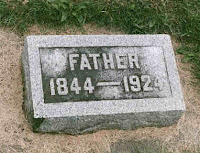 |
| Baier House circa 1911 (Lawler Farm Collection) |
 |
| Circa 1893 John, Liz, Fan, Nan, Kate ..., John, Eva, Mary, Sadie Lawler Farm Collection |
John, in his pension papers, remembers that they moved to Olmstead Co, MN the year of the Chicago Fire, which is corroborated by his wife, Mary Delmore Baier's recollections. "We lived there until I think 1871. I had one child when we came to Rochester Minnesota, since then born to us have had 12 children of which seven of my children are living, all of whom are married and out in the world for themselves."
John and Mary were reported to have had thirteen children in the Olmsted County History which was written while both were still alive. Some relatives recall hearing of twins who died at birth and are buried on the farm in Haverhill. Of the other two nothing is known.

Over the years John added another 160 acres to his holdings, all of which he farmed for many years and later deeded to his son, John Matthew. "....John was an exceptionally good farmer. He worked hard and methodically and accomplished much. His first farming was done with oxen ( a quick stepping ox could plow 1 1/2 acres a day. Sunday he considered the Lord's day and would allow no work no matter what the situation or weather. In later years he made it a daily practice to call the Grain Exchange in St. Paul for the latest information. John always claimed he would quit farming when he had saved $50,000. After years of successful farming the time came to retire and move to Rochester. He had put in years of hard labor and had achieved his goal. His wife Mary had other ideas. She was determined not to leave the farm. She had always had a will of her own, but John and his daughters found a nice home at 611 East Center Street. They did the arranging and the moving. Mary finally agreed to move--under protest. She moved a lot of her farm home treasures and finally fixed the home to her liking. They resided there from 1908 until their deaths.
"John started life as a poor boy but was industrious and frugal and so won success. He was active in his community and served in many local positions of trust. He and his family were members of the Roman Catholic Church. John English, his oldest grandson remembered well the summers he spent on his Grandfathers farm. He recalls how he worked in the fields and garden, how he was instructed to keep a detailed report of his hours and activities, and how he was paid at the end of the summer after having a heart to heart talk with the old gentleman. His grandmother's cooking was another highlight for him. She made cookies as no other woman could and the tale of her wonderful dishes has passed down through the generations." (Granddaughter Dolores English Young Genealogical Notes)
John died on 1 Jun 1924 without having written a will. His estate therefore was divided 1/3 to Mary and 2/21 to each of his seven living children. The estate which was initially valued at $29,200 was settled at 40090.77. After expenses there was 36595.16 left to distribute. The farm however was not sold so the actual distribution of $10693.39 to Mary and 3569.04 to each child, was nearly halved with Mary receiving $5609.16 and each child $1064.01. The lot on which the Baier/s lived in the Rochester was considered a homestead and was appraised for $5000.
Murphy. When family visited in 1999 the cemetery had been renamed Calvary and the parish priest at St. John's Church die not remember it being called St. John's. The name probably was changed when Rochester grew large enough to have more than one Catholic Church and the graveyard no longer was used exclusively by St. John's.
John Baier - Dropbox


No comments:
Post a Comment